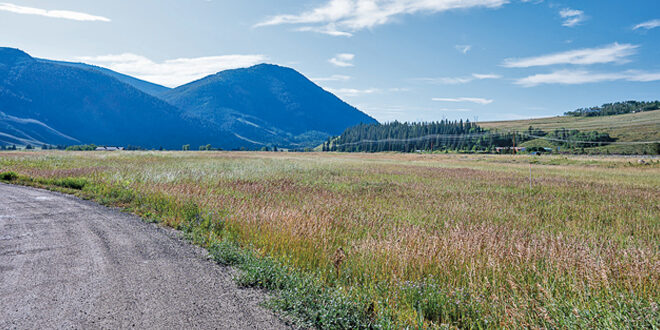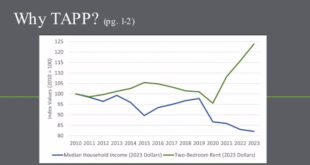No commercial, more open spaces increasing highway setbacks
[ By Katherine Nettles ]
The sketch plan application for a major new subdivision dubbed Starview near Crested Butte South continues to develop as a joint public hearing with Gunnison County commissioners and the planning commission held last week did not reach any conclusive end after hours more of deliberation. The developer has begun making some significant changes to the proposed site plan since the December public hearing, and the planning commission determined it makes more sense to give them time to formally submit those changes for planning commission review and a new public hearing in the future.
The developer team for Oklahoma-based firm HGC addressed several points of contention during the February 6 continued public hearing, most of which were raised at the previous hearing on December 19. And despite the developer eliminating commercial units, adding more open space and slightly reducing the number of units, the planning commission gave feedback that there was more to do to make the application fit the community character surrounding it, and submitting those changes formally would allow for a more thorough public review process.
HGC first approached Gunnison County with the project idea in 2022 for 76 units over 90 acres on a parcel along Highway 135 just south of CB South. After several work sessions with the planning commission and feedback that more density and commercial opportunities might be ideal so close to water treatment and other infrastructure, the proposal had changed to 129 lots, with 84 single-family homes, 44 multi-family units including deed restricted units, and four residential units located above commercial spaces.
The December 19 public hearing brought forward numerous concerns from community members and planning commission members regarding the commercial spaces, the density and the impact of such a project on traffic, community services, wildlife and view corridors in the area.
At the continuation on February 6 the developer team updated the commission and attendees that while they had not submitted formal modifications after the last meeting, they had come up with some changes and hoped to gauge the commission’s reaction to make sure they were on the right track. That was not received positively.
First there was disagreement between the applicant and the Gunnison County Community Development staff and planning commission members over how communications were conducted since the last meeting. Applicant representative Gary Huresky stated they did not get documentation with a summary of the planning commission’s concerns until January 30, and their applicant response had been due January 27.
Planning commission members, county commissioners and county staff maintained that the developer had received more than ample feedback from them and the public prior to and during the December hearing and that the developer should have addressed the myriad concerns without further prompts.
County commissioners and planning commission members also said they were uncomfortable with the developer requesting planning commission consensus to spontaneous changes during the continued hearing.
“This is starting to have this feel like it’s ‘we’ll just keep scratching stuff off or moving things around until you’re happy,’” said county commissioner Jonathan Houck. “This feels not fully developed.” He added that after the last meeting he believed the concerns to address were clear enough without a memo.
Commissioner chair Laura Puckett Daniels said that sketch plan phase is meant to be conceptual, engaged in dialogue and a negotiation between the applicant and the planning commission. “But what has happened is that there have been I don’t even know how many work sessions…the hope is that what you arrive with at the public hearing is really what you want to do after those work session negotiations. And changes can still be made, but I feel like you are asking us to design the parcel for you sometimes.” She acknowledged that the applicant wanted some clearer direction from them but emphasized that they would find a diversity of opinions among board members. “That’s part of what we hope for,” she said, to represent the diversity of the community members.
Puckett Daniels also cited the county’s housing needs assessment identifying the need for more homes priced below $782,000.
“If we want free-market, attainable housing, it has to be under that $782,000 mark,” she said, and commented that 2,500-square-foot homes and amenities like two-car garages would drive costs up too high to be attainable for most valley residents.
The applicant team said they had made changes to the site plan based on feedback, but some comments directly contradicted one another, and it was difficult to navigate what the planning commission wanted. Developer attorney Mike Dawson described three significant changes: the team had removed the four commercial/residential units, increased setbacks along the highway by 200 feet to better preserve the view corridor and removed six home lots from the southwestern corner of the site, leaving open space adjacent to existing homes and conserved Land Trust property.
Dawson also clarified that there would now be 119 lots total, and the maximum home sizes would be 2,500 square feet, stating those numbers had been reported incorrectly among community members. He argued that the plan addressed a dire housing need at the size needed in the community.
Huresky added, “We chose this path because we thought there was a community need for housing.” He argued that to drastically reduce density would not achieve affordability as the current proposal has average lot sizes of one-quarter to one-third acres, and some along the river are closer to one half or three-quarter acres. “We could do larger lots at four acres each. And who would those serve? No one in this community.”
There were several positive reactions to the changes the applicant proposed and both public comments and planning commission remarks indicated they were on the right track, although the tension over how to integrate feedback continued throughout the meeting and several county officials and attendees indicated they wanted to see more deed restricted units and more open space.
During public comment, Reggie Masters said the original plan she saw had no commercial, and she believed the planning commission was causing undue complications by asking for commercial, then asking the applicant to pull it out in response to public comments.
“It seems to me that you [planning commission] are the ones who are making it disjointed,” she said. Masters also responded to Puckett Daniels’ statements about garages.
“Everybody who lives here has toys,” she pointed out. “It trashes the neighborhood if that’s all outside.” Overall, she applauded the developers for pulling back on commercial lots and increasing the setback from the highway.
More than a dozen other public comments reiterated previous concerns that the development would cause population increases, stress services and wildlife and diminish the viewsheds, natural resources and community character of the area. Some comments, like those submitted by Courtney and Gregory Larder, expressed mixed feelings about the project with hope for more homes in CB South but sharing the impact concerns of others and wishing for more deed restricted units. Many board members also asked for more than 20 deed restricted units in the proposal.
Planning commission member Kathy McBride spoke to the conundrum with some community members asking for less density but also wanting affordability. She wanted to make clear to the community that it is not the job of the developer to address services.
Planning commission member Fred Niederer said many factors, including traffic studies, price points and infrastructure engineering and feasibility studies come at preliminary plan and asking for them now is premature.
“I do feel they have made great strides in listening to the community,” he said.
Houck said the proposal needs some more community-oriented amenities, such as field space, walkability and a bike path.
After a couple hours of commentary, the commission weighed its options ranging from approval, denial, continuance or closing the hearing until a later date. They decided unanimously to close the public hearing and give the applicant a chance to fine-tune its application before further review.
“I think a clean plan brought to us again is more appropriate,” summarized Niederer.
Once that updated application is complete the board will reconvene for a work session and reopen a new public hearing to consider it.
 The Crested Butte News Serving the Gunnison Valley since 1999
The Crested Butte News Serving the Gunnison Valley since 1999




